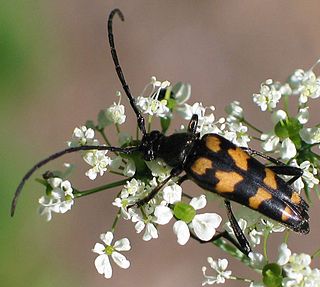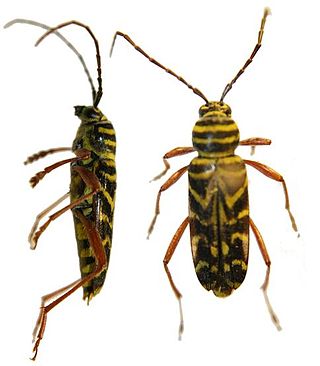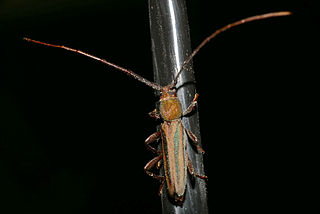
The Prioninae are a subfamily of Cerambycidae. They are typically large (25–70 mm) and usually brown or black. The males of a few genera sport large mandibles that are used in fights with other males, similar to stag beetles. These beetles are commonly nocturnal and are attracted to light. The majority of the Prioninae whose biology is known are borers whose larvae feed on rotting wood or roots.

Cerambycinae is a subfamily of the longhorn beetle family (Cerambycidae). The subfamily has a world-wide distribution including: Asia, Europe and the Americas. Within the family, the only subfamily of comparable diversity is the Lamiinae.

Strangalia is a genus of beetles in the family Cerambycidae, containing the following species:

Coleoxestia is a genus of Long-Horned Beetles in the beetle family Cerambycidae. There are more than 50 described species in Coleoxestia, found mainly in Central and South America.

Megacyllene is a genus of beetles in the family Cerambycidae, containing the following species:

Elaphidiini is a tribe of beetles in the subfamily Cerambycinae, historically also often spelled "Elaphidionini".

Anelaphus is a genus of beetles in the family Cerambycidae, first described by Earle Linsley in 1936.
Stizocera is a genus of beetles in the family Cerambycidae, containing the following species:
Rhinotragini is a tribe of beetles in the subfamily Cerambycinae.
Acanthoderes is a genus of beetles in the family Cerambycidae, containing the following species:
Eupromerella is a genus of beetles in the family Cerambycidae, containing the following species:

Oreodera is a genus of long-horned beetles in the family Cerambycidae. Oreodera is in the subfamily Lamiinae, the flat-faced longhorns. There are more than 100 described species in Oreodera, found in Central and South America.

Obrium is a genus of longhorn beetles in the tribe Obriini, erected by Dejean in 1821.

Plistonax is a genus of beetles in the family Cerambycidae.
Scythropopsis is a genus of beetles in the family Cerambycidae, containing the following species, most of which were formerly classified under the genus name Psapharochrus:

Desmiphora is a genus of longhorn beetles of the subfamily Lamiinae, containing the following species:
Estoloides is a genus of longhorn beetles of the subfamily Lamiinae.

Eupogonius is a genus of longhorn beetles of the subfamily Lamiinae. It was described in Journal of the Academy of Natural Sciences of Philadelphia by John Lawrence LeConte in 1852. The species live across Eastern North America, south to Argentina, in forests and woodlots.

Xystrocerini is a tribe of longhorn beetles in the subfamily Cerambycinae, erected by Blanchard in 1845.
Adetaptera is a genus of beetles in the family Cerambycidae, most of which were formerly in the genus Parmenonta.













